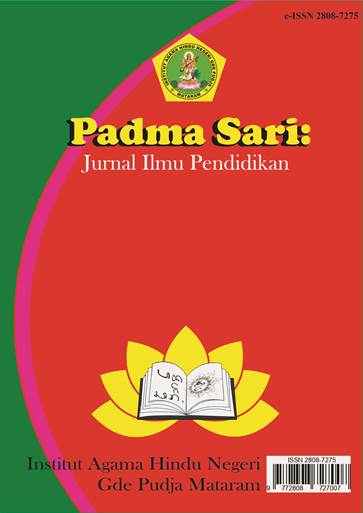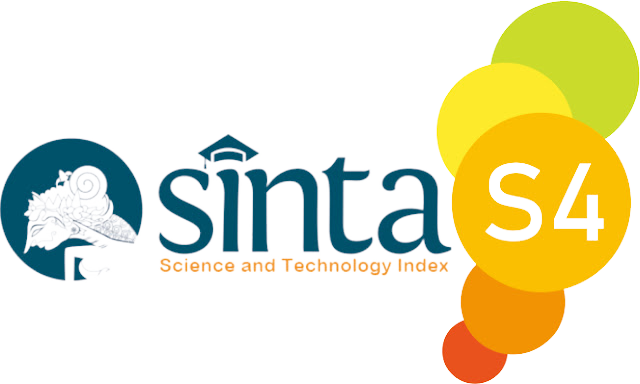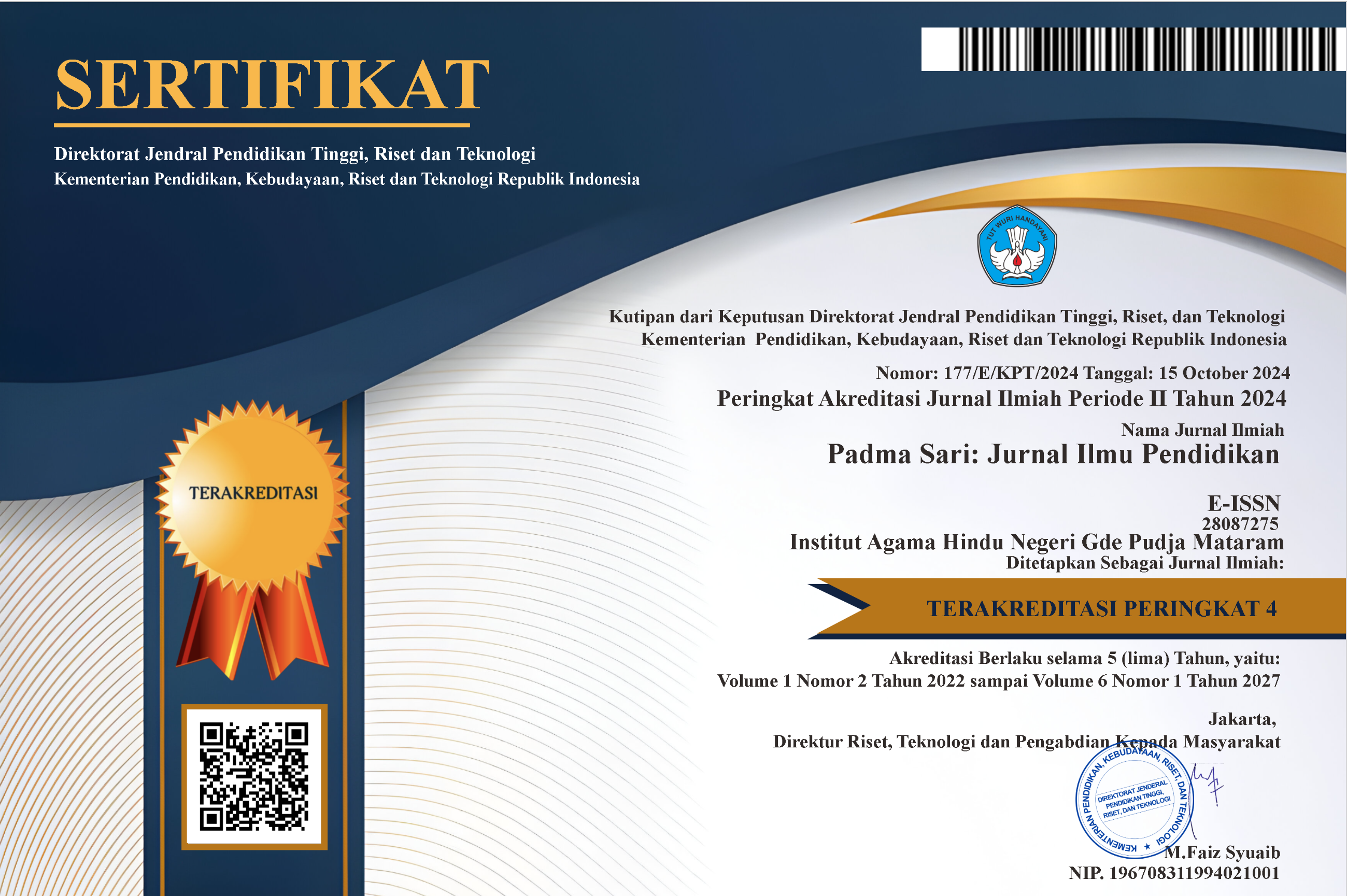THE IMPLEMENTATION OF PRANATAL EDUCATION IN MAGEDONG-GEDONGAN CEREMONY AT HINDU COMMUNITIES IN URBAN OUTSKIRTS
Abstract
This article is the result of research that aims to conduct a study of the implementation of the magedong-gedongan ceremony in Hindu communities living in urban outskirts areas focused in Batubulan Village as a form of implementation of prenatal education. The design of this research is descriptive interpretive to interpret the implementation of the magedong-gedongan ceremony associated with the concept of prenatal education. Most of the data taken in this study were in the field, which were then analyzed using interpretive descriptive analysis techniques. This study found that the implementation of the magedong-gedongan ceremony is an obligation that must be carried out as an effort to purify babies who are still in the womb. Although it is an obligation, not all Hindus do it for certain reasons. The implementation of the magedong-gedongan ceremony of the purification process is also a process of prenatal education given to babies who are still in the womb with the hope that after birth they can grow and develop into children who are physically and mentally healthy. Aspects of prenatal education given to the baby who is still in the womb in the form of positive values emitted by the implementation of the magedong-gedongan ceremony which is believed to be accepted by the baby in the womb in forming multiple intelligences.
References
Cika, I. W. (2018) Implementation Of Hindu Teachings In The Dukuh Siladri Geguritan Text. Proceeding Book-International Seminar Bali Hinduism, Tradition and Interreligious Studies. Denpasar: Hindu University of Indonesia
Damayanti, N. L. A. E. (2020). Pelaksanaan Upacara Magedong-gedongan Menurut Ajaran Agama Hindu. Widya Genitri: Jurnal Ilmiah Pendidikan, Agama Dan Kebudayaan Hindu, 11(1), 60-70.
Dewi, N.W.A., dkk. (2017). Tumbuhan Bahan Upakara Dalam Upacara Magedong-gedongan di Desa Sukawati, Kecamatan Sukawati Kabupaten Gianyar. In the Prosiding Seminar Nasionan Fakultas MIPA UNHI: Penguatan dan Pengajaran Biologi Sebagai Ilmu Dasar. Denpasar: Universitas Hindu Indonesia. pp. 275-285.
Hidayah, R. N. (2016). Penerapan Strategi Multiple Intellegences Perspektif Howard Gardner Pendidikan Anak Usia Dini di Indonesia. Al-Mabsut: Jurnal Studi Islam dan Sosial, 10(1), 173-185.
Jelantik Oka, I.P.G.N. (2009). Sanatana Hindu Dharma. Denpasar: Widya Dharma.
Kartini Kartono. (1996). Pengantar Metodologi Riset Sosial. Bandung: Mandar Maju.
Martha, W. (2015). “Mengungkap Misteri Tirta”. In book Revitalisasi Agama Tirta di Bali. A. Paramita (Ed). Tabanan: Pustaka Ekspresi.
Pudja, G. (2003). Bhagavad Gītā: Pancamo Veda. Surabaya: Paramita.
Suamba, I.B.P. (2014). Pasu Yajňa dalam Kesusastraan Weda. Denpasar: Yayasan Dharma Sastra.
Suhardi, U. (2014). Merekonstruksi Sistem Pendidikan Hindu Dalam Upaya Menumbuh Kembangkan Budi Pekerti Pada Anak Untuk Menjadi Insan Cerdas dan Kompetitif. Jurnal PASUPATI, 3(1), 21. http://dx.doi.org/10.37428/pspt.v3i1.25
Sumertha, I. W. (2020). Pola Pendidikan Pranatal dalam Agama Hindu. Tampung Penyang, 18(01). https://doi.org/10.33363/tampung-penyang.v18i01.478
Suprayogo, Iman dan Tobroni. (2001). Metodologi Penelitian Sosial-Agama. Bandung: Remaja Rosdakarya
Surayin, I.A.P. (2005). Melangkah ke Arah persiapan Upakara-Upakara yajña. Surabaya: Paramita
Wirawan, I. W. A., Sura, I. G., & Wardana, K. (2020a). The Synergicity of Essentially the Identity of God in The Vedic Teaching and the Siwatattwa as Guidelines for Hindu Religious Practices in Bali. Jurnal Penelitian Agama Hindu, 4(4), 213-236. https://jayapanguspress.penerbit.org/index.php/JPAH/article/view/1225
Wirawan, I. W. A. (2020b). Dynamic Ideology of Traditionality in Developing Holy Places at Hindus Family in Cakranegara Territory Mataram City. Satya Widya: Jurnal Studi Agama, 3(1), 27-52. https://doi.org/10.33363/swjsa.v3i1.435
Tim Penyusun. (2006). Buku pendidikan Agama Hindu untuk Perguruan Tinggi. Surabaya: Paramita
Tim Penyusun. (2008). Panca Yajña. Denpasar: Widya Dharma.

This work is licensed under a Creative Commons Attribution 4.0 International License.




















